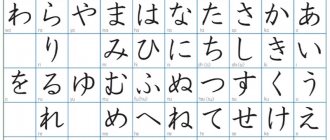Garbage reform has started in Russia, but the population does not have a clear idea of its implementation. And about the benefits that society and our descendants will receive. In the end, will it be beneficial for the environment? So far, the concept of reform revolves around tariffs for waste collection and disposal. And only in certain regions are they talking about separate waste collection and sorting. But so far the puzzle is not coming together. How is this issue resolved in other countries? For example, in Japan, which has very limited free space to organize burial grounds. How waste is sorted in Japan. Maybe the Japanese experience will be useful for us too?
Share and save
Residents of Kamikatsu claim that over the 15 years of the environmental experiment, painstaking sorting of absolutely all household waste has become a habit: just like drinking your morning coffee, throwing away the used filter in a special container.
Putting 34 trash cans in your home is pure madness. But this is not necessary, since there is constantly generated garbage. For example, organic household waste (vegetable peelings, egg shells). And there is one that is thrown away infrequently. For example, batteries or completely worn out items.
There are no centralized garbage bins in the town. Each family brings its garbage directly to the recycling center, where workers carefully check whether a “foreign” item has ended up in one or another bag.
Every resident of the town, and there are a little more than one and a half thousand of them, has a 27-sheet memo that describes in detail how to deal with garbage. In addition, at the recycling center, above each container there is a kind of information board that tells you what this garbage will turn into and why it needs to be stored separately from other waste.
Islands made of trash
An alternative way to process solid waste (solid waste) is to use it in construction. Benches made from recycled paper are often found at bus stops, glass dust is used in the production of roadside barriers and paving slabs, but the most interesting are the so-called garbage islands in Japan.
Recycled paper and ashes left over from waste incineration are pressed into briquettes, which are subsequently laid into the foundations of artificial islands that are built for luxury housing, parks, metallurgical plants and airports. 249 square kilometers of Tokyo Bay are covered with recycled waste. Land prices in man-made areas made from recycled materials are many times higher than in conventional areas.
Waste recycling in Japan is showing amazing results. According to estimates by the Japanese Ministry of Environmental Protection, in 2018, each person in the country leaves on average 191 grams of waste less than 10 years ago, the vast majority of which is recycled and reused without harming the environment, which leads to a further reduction in waste generated. Every year the government allocates huge amounts of money to develop new effective measures for recycling and environmentally friendly waste processing.
Zero Waste Life
The motto of the Kamikatsu environmental experiment is all in. Why recycle something that could be useful to a neighbor? The town has opened a kind of exchange office - Circular - where every resident can bring things they don’t like and take back what they like, absolutely free. There is also a factory in Kamikatsu that recycles everything that can be recycled: old items are remade into new models. Souvenirs and bags are made from fabric, accessories and other textiles. Although “factory” is too strong a name. This is mainly done by local retired women.
In 2001, Tokushima Prefectural authorities decided to build two waste incineration plants in the vicinity of Kamikatsu. However, the mayor of the town abandoned this initiative, despite considerable subsidies, in favor of recycling all waste locally. During the experiment, a small Japanese town managed to achieve the impossible - 80% of their garbage gets a second life and only 20% goes to landfills. By 2021, Kamikatsu has ambitious plans to achieve a 100% “garbage-free” life. Now schoolchildren and students, as well as environmentalists from all over the world, are taken to Kamikatsu on excursions.
Disposal in Germany
Several years ago, a unique waste sorting system was created. For this purpose, there are garbage containers in houses or in front of apartment buildings. They were divided there by color.
- Cardboard and paper are thrown into the blue ones.
- Plastic containers, bottles and other containers are thrown into the yellow ones.
- In gray - food waste.
- The green houses recycle glass; there are containers for it on many streets.
Citizens of this country were required to sort their garbage, and manufacturers were required to recycle their packaging material. Companies involved in waste disposal are issued licenses. For example, better known under the Green Dot brand, it provides housing with yellow containers into which packaging made from plastic, metals or mixed materials, as well as containers for glass, are thrown away. Housing and communal services companies provide containers and collect and remove other waste. In the city of Bonn, for example, the municipal government is responsible for garbage collection on behalf of the city authorities. Their task is to collect waste paper, cardboard packaging, broken equipment and household appliances, items containing toxic substances and bulky waste, in general, solid waste.
Every city bin has its day when it is emptied and its contents end up in a garbage truck. The schedule for bypassing garbage containers is drawn up for the whole year. Every resident of the country receives this schedule by mail; the fee for waste removal and disposal varies and amounts to around 150 euros per year. You can also be provided with a furniture disposal service free of charge - once a year, but you must first take it outside. Waste incineration plants operate 24 hours a day, seven days a week. Recycling is on stream. The system is set up like clockwork, paper and glass containers are sent for recycling, biological residues are sent to compost, and electricity and heat are obtained from the rest of the waste after sorting and special treatment. 2/3 of the waste is recycled, 1/3 is burned. This is due to resource savings; 14% of all raw materials used in German industry are obtained from waste. The entire range of waste is recycled - old computers, televisions, mercury lamps and even wine bottle caps. Collection points for recyclable materials have been created in every city; citizens bring here everything that they no longer need, but cannot be thrown into trash cans. Waste separation in such a pedantic country as Germany is strictly monitored. Violators are subject to serious administrative penalties. They are either fined or may stop servicing the house, with notification of everyone living in it.
Japanese model of the “garbage miracle”
The example of Kamikatsu is a model of how Japan treats the environment in general and garbage in particular. In the middle of the last century, an era of rapid industrial growth began there on the relatively closed territory of the islands, plus the development of consumerism and the entertainment sector. All this led to environmental pollution and, as a consequence, a significant deterioration in the health of the Japanese.
In the 90s, Japan became deeply involved in the environment. The struggle for a clean environment was carried out using the stick method - “The polluter pays himself!” and carrots - state support for enterprises implementing environmental programs, including waste recycling. At the same time, explanatory work is being carried out for the population on how important it is to reduce the amount of garbage and sort it.
Many municipalities collect different types of garbage on different days - combustible (food scraps, snack wrappers, dirty paper, fabric, clothing, wood, small trash, vinyl, rubber), non-combustible (metal objects, ceramics, glass, small appliances, fluorescent lamps). Glass and plastic bottles, paper, and metal cans are collected as recyclable materials. Household appliances - refrigerators, televisions, air conditioners - are disassembled, rare earth metal elements are removed and reused.
In many cities, bags of different colors are used for different types of garbage, although transparent bags are now increasingly being used to make it easier to control the correct sorting.
There is a strictly designated time for throwing out garbage. For example, non-burnable waste is collected from 10:00 to 12:00 every Wednesday, cardboard and other paper - on the first and third Monday of each month, and organic waste - on Tuesday and Saturday. Moreover, during national holidays, garbage collection services may not work.
Garbage collection schedules are set by the local administration. There is a fine for failure to comply with mandatory standards, but even this does not frighten the Japanese as much as the prospect of building a waste incineration plant right next door.
Disposal of non-recyclable waste
Special attention is paid to the recycling of computer equipment and household electrical appliances. Manufacturers are required by law to build special recycling plants where disused devices are transported. Consumers can mail unwanted items or pay for collection and transportation services when they need to drop off large equipment. Batteries, accumulators, and lighting devices are disposed of with extreme care, as they are hazardous to the environment.
The Vehicle Recycling Act requires original owners to purchase a recycling voucher. When reselling, the buyer not only pays for the car, but also reimburses the seller for the cost of the coupon. The last owner hands over the car along with the coupon to a special agent who is then responsible for disposing of the car.
European experience
The problem of recycling and sorting waste is acute in Europe. And while the consciousness of Europeans has not reached the level of the Japanese, the authorities have to invent life hacks.
- Typically, different types of waste are thrown into containers or bags of a specific color. And for those who are too lazy to sort, they can buy a special bag for two euros and put everything in it - for this money, a specially trained person will sort the garbage;
- There are so-called “garbage detectives” who can track down a violator using a receipt from a store or a piece of a parcel with an address;
- Containers for collecting garbage have special holes. For example, a glass bottle will not fit into a container for paper or cans.
Disposal in Switzerland
There are no landfills here. In this country, the issue of recycling has been resolved radically. There are approximately 160 street collection points for waste sorting in Zurich. And citizens disciplinedly throw out separately:
aluminum cans, glass bottles, waste paper and other garbage
All this because it is profitable. 43% of household waste is reused instead of being recycled. Throwing away plastic costs a fee, approximately 1.5 euros. People are interested in having as much plastic packed into special bags as possible. If someone is careless in sorting, they will be found out. The country of Switzerland is high-tech, here specially created services monitor violators, and for the first time they are limited to warnings; in case of repeated violations, measures are taken against them, including the involvement of the police. Bulky waste is brought by citizens to sorting points at the incineration plant. Old furniture, broken and old household appliances, textiles, etc. are brought here. In Switzerland, there is a law that requires waste to be disposed of by incineration, and not stored somewhere. In the canton of Zurich there are five plants that burn and convert all waste into energy. Landfills in Switzerland ceased to exist decades ago. In this country, waste disposal is aimed at the benefit of its residents. Residential buildings are heated using the energy of incinerated waste through central heating networks - this is a high indicator of the country's development. And from the ashes remaining after the burned material, non-ferrous metal and even gold are extracted.
Payment for old equipment
And in order to dispose of a TV or refrigerator, the Japanese will still have to pay extra. Household appliances are not classified as bulky waste. You must pay separately for its disposal. The equipment is taken to the store where the equipment was purchased, and the manufacturing company is paid for disposal.
Most importantly, this practice led to good results. As a result of recycling household appliances, the country receives more than 1 million tons of iron and 50 thousand tons of non-ferrous metals per year.
But an attempt to throw away unnecessary equipment and electronics without paying for it results in fines of several hundred dollars. But there are not many cases of such unconsciousness. Organization and love of order are in the Japanese blood.
Use of waste in production
Non-combustible waste also has its uses. The slag formed as a result of thermal treatment of waste is turned into durable briquettes, from which buildings are erected and even new islands are built. Modern technologies have made it possible to make such artificial islands strong enough for the construction of residential complexes, parks, even airports and industrial enterprises on them. As a result, garbage not only does not reduce the useful areas of the country, but also helps create new ones.
Other types of waste are also subject to various recycling methods:
- Broken glass is used to make new bottles; it is also used in construction to make new materials and wall decoration.
- Various types of plastic are being actively processed . Recycled materials are used to make clothing, rugs, bags and many other everyday items.
- Recycled paper is used to produce pulp with a wide range of industrial applications.
Almost every type of waste that can be recycled is used with maximum efficiency. Japan recycles up to 90% of its waste, although this does not completely solve the garbage problem. Currently, public opinion is changing from the idea of complete recycling to the philosophy of living with a minimum amount of waste.









